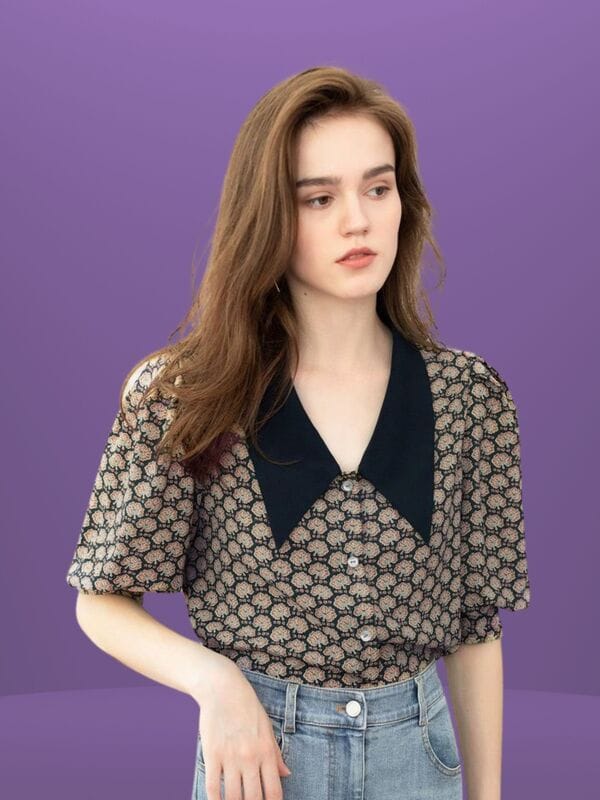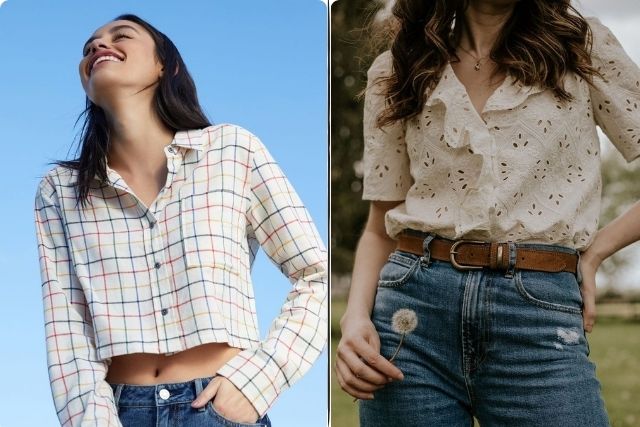Blouse vs. Shirt: What is the Difference?

As an Amazon Associate, I earn from qualifying purchases
You’re not alone if you’ve ever needed clarification about the difference between a blouse and a shirt. Many people use these terms interchangeably, but the two have some distinct differences.
In this post, we’ll break down Blouse vs. Shirt. We’ll discuss the key characteristics. This will help you confidently differentiate between the two. You can then choose the right option for any occasion.
Definition of a Blouse and a Shirt
A blouse is a loose-fitting, often more formal top typically worn by women. It usually has a collar and buttons down the front. It may also have more intricate or decorative details such as ruffles, lace, or embroidery. Blouses are often made from lighter, flowy fabrics such as silk or chiffon.
On the other hand, a shirt is a more structured, tailored garment that can be worn by both men and women. It typically has a collar and buttons down the front and may have a more fitted or slim-cut silhouette. Shirts are often made from sturdier fabrics such as cotton or denim.
Historical and cultural of blouses and shirts
Blouses and shirts’ historical and cultural significance can be seen throughout various time periods and regions. Blouses have been a staple in women’s fashion for centuries. Different styles and designs reflect the cultural and societal norms of each time period. In the 19th century, blouses often had high collars and ruffled details. These elements reflected the modesty and femininity expected of women during that era.

Shirts, however, have a long history dating back to ancient civilizations. Both men and women have worn them and have evolved to reflect the changing fashion trends and societal norms. For men, shirts symbolize formality and professionalism, often worn with suits or formal attire. In recent years, shirts have become popular in women’s fashion. There are various styles and cuts available. These styles suit different preferences and occasions.
In many cultures, the design and style of blouses and shirts hold significance in traditional dress and ceremonial attire. For example, in Indian culture, the conventional sari blouse is essential to the overall outfit. It can be intricately designed with embroidery and embellishments. In some African cultures, shirts with distinct patterns are worn to symbolize cultural identity. Their colors represent heritage.
Different styles and designs
While blouses and shirts come in various styles, each category has its defining characteristics. A blouse often features softer, more delicate fabrics like silk or chiffon, with intricate details like ruffles, lace, or embroidery. Shirts are generally made from sturdier materials like cotton or linen. They have a structured fit with tailored elements like collars and cuffs.
Fashion-forward workwear and casual Fridays have risen. Because of this, the lines between blouses and shirts have blurred. Blouses now adopt more traditional shirt elements like collars. In contrast, shirts now come in more feminine styles.
Practical considerations
Practicality plays an essential role When deciding between a blouse or a shirt for your next outfit choice. Blouses are more versatile, easily transitioning from day to night with the right accessories.
Thanks to their diverse range of styles, they also offer more room for personalization and creativity. However, shirts are a solid choice for professional settings or occasions that require a polished look. Their structured fit and traditional style make them a safe bet for any wardrobe.
How to Style and Accessorize Blouses and Shirts

Shirts:

When to wear a blouse & when to wear a shirt

It can depend on the occasion and personal style. Blouses are typically considered more formal and are great for work, business meetings, or special events. They often have more intricate designs and feminine details and are made of softer, more delicate fabrics.
On the other hand, shirts are frequently seen as more casual and practical. They are perfect for everyday wear, running errands, or a casual day out. They are usually made of sturdier fabrics and have a more structured, utilitarian feel. However, blouses and shirts can be styled for different occasions and personal preferences. It’s all about finding the right style and comfort for your needs.
Popularity and Trends
Trends have played a big role in the ups and downs of the popularity of blouses and shirts. Peasant blouses were a total fave in the 1970s. They made a comeback in the 2000s with a cool twist. This included rocking beading and longer tunics. And who can forget the cold-shoulder and bell-sleeve shirt trends? They brought a fresh vibe to a timeless style in the past few years!

Popularity contests also extend to the historical context of each garment! The shirt’s repeated reinvention—from workwear to evening attire—has kept it a timeless choice that always adapts to the fashion backdrop. The blouse has chameleon qualities. It mirrors the trends of the femininity movement. Designers constantly discover fun ways to play with its classic silhouette.
Practical Guide
For those browsing through a fashion boutique, knowing the difference between a blouse and a shirt can set the tone for your style! Let’s give you some helpful cues:
- Fabric and Fall: Keep an eye on the fabric. Silk, chiffon, and velvet usually gravitate towards blouses. Denim, oxford cloth, and poplin are more shirt-friendly. How does it drape when hanging? A softer, less structured fall might suggest a blouse.
- The Collar and Cuff: Classic collars and cuffs with buttons are associated with shirts. Rounded or bow tie necklines and fancy cuffs create a more blouse-like vibe.
- The Silhouette Test: When you hang it up, does it look more relaxed and casual? It could be a blouse. If it’s straighter and snugger, it’s usually a shirt.
- Occasion Wear: Think about the occasion. Is it for a fancy event or a chill hangout? The amount of bling and the stiffness of the fabric can give you some clues.
Blouse vs. Shirt: What To Choose?
In conclusion, the key differences between blouses and shirts lie in their design, fit, and style. Blouses are typically more tailored and feminine, often featuring ruffles, lace, or other decorative elements.
At the same time, shirts are more structured and usually have a button-down front. Understanding these differences can help you choose the right garment for any occasion. They also ensure that you always look and feel your best.
FAQ
A blouse is typically a more feminine and dressy top, often with ruffles, lace, or other decorative elements. A shirt, on the other hand, is usually a more casual and unisex garment, often with a collar and buttons.
Yes, a blouse can be considered a type of shirt, but it is generally more specific to women’s fashion and tends to have more intricate and decorative designs.
As an Amazon Associate, I earn from qualifying purchases









